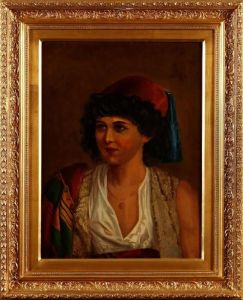Urolli Paintings
Vincenzo Irolli, often misspelled as Urolli, was an eminent Italian painter born on September 30, 1859, in Naples, Italy. Irolli's artistic journey began at a young age, showing early promise that led him to study at the prestigious Academy of Fine Arts in Naples. Under the guidance of noted instructors such as Domenico Morelli and Gioacchino Toma, Irolli honed his skills, developing a distinctive style characterized by its vibrant color palette, dynamic compositions, and emotional depth.
Throughout his career, Irolli was deeply inspired by the everyday life of his native Naples, capturing scenes of its people, landscapes, and urban life with a sensitivity and warmth that endeared him to both the public and critics. His works often depicted moments of ordinary life, imbuing them with a sense of dignity and beauty. This focus on the quotidian, combined with his technical prowess, placed Irolli among the leading figures of the Italian verismo movement, which sought to depict the reality of life with honesty and without idealization.
Irolli's talent was recognized early on, and his works were exhibited in numerous national and international exhibitions, earning him accolades and awards. Notably, his paintings were featured in major exhibitions such as the Promotrice di Belle Arti in Naples and the Venice Biennale, where his ability to capture the essence of Neapolitan life in his art was particularly lauded. His success allowed him to establish a studio in Naples, which became a hub for artists and intellectuals, further solidifying his status in the Italian art world.
Despite his success, Irolli remained deeply connected to his Neapolitan roots, and this connection informed much of his work throughout his career. His paintings are notable not only for their technical skill but also for their emotional resonance, capturing moments of joy, sorrow, and the everyday with a palpable sense of empathy.
Vincenzo Irolli passed away on December 27, 1933, in Naples, leaving behind a legacy that has continued to influence Italian art. His works are held in numerous public and private collections around the world, testament to his enduring appeal and the universal themes of humanity that he so adeptly captured in his art.
